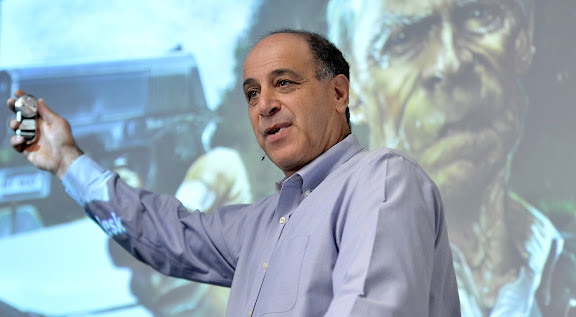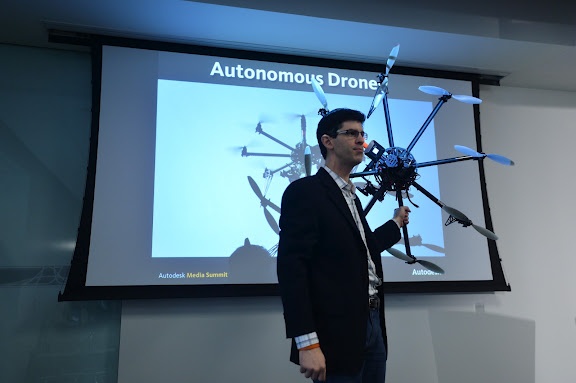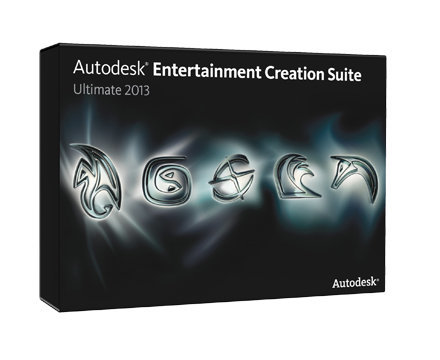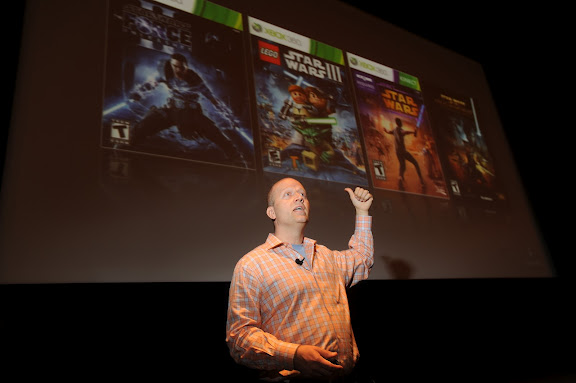The first half of the day started with presentations by the corporate brass, which announced Autodesk's recent successes and gave some insight into their future goals. The day concluded in break-out sessions with the various product managers. The second day included case study presentations by several of Autodesk's key customers.
Words from the CEO
The opening presentation was made by Carl Bass, the president and CEO of Autodesk. He spoke of the strength of Autodesk in this troubled economy. Over the past year, Autodesk exceeded their aggressive goal of 10 percent growth by growing an impressive 14 percent. He also stated that over 75 percent of Autodesk's business is done outside the U.S.

Figure 1: Carl Bass, President and CEO of Autodesk, delivered the opening address, image courtesy of Autodesk
Mr. Bass reflected on a presentation made two years ago where he noted that the entire computer landscape was changing. The platform was moving from desktop workstations to a mobile, social and cloud-based computing. Just as the shift between mainframes and workstations shook up the way we do business, this change has the potential to be even more disruptive. Mr. Bass stated, "We're moving to a world where the computing center of the world is where you are."
He then showed with some pride how Autodesk has answered the call to support these new mobile, social and cloud-based platforms. He mentioned how in years past, engineers were PC-centric and would always say that they would email the files once they get back in the office, but now they can call up their applications on their mobile device and email it immediately to the client. AutoCAD WS is a good example of this. "AutoCAD WS launched less than 2 years ago. Now over 7 million users are accessing it. 300,000 files are uploaded to AutoCAD WS a week, that's 1,800 per hour, 30 files every minute," said Carl Bass. This is proof that mobile devices are being used extensively by Autodesk users.
Another popular application on mobile devices is Sketchbook, which has been downloaded over 10 million times with 150,000 new downloads happening per week. This technology is allowing artists to be more creative than ever. When seeing the quality of art produced on these mobile devices, a viewer commented in amazement, "I can't believe someone drew this on their phone."
The Force Effect software is yet another example. It enables advanced kinematics simulations on an iPad causing one university professor to complain how his students cheated on their homework by using this advanced new software instead of doing it the old fashioned way of pencil and paper.
On the social front, several Autodesk sponsored web sites provide places for communities of users to interact. The recently acquired Instructables.com site has 13 million visitors a month and the PIXLR service, which offers online photo editing has had over 21 million visitors.
The Future is Cloudy
To talk more on Autodesk's cloud initiatives, Ahmar Hanspal, Senior Vice President, Information Modeling & Platform Products Group, presented next. He mentioned that the days of the stand-alone applications is over. The current set of Autodesk products are designed to work together and the products are designed to be cloud-centric. "The cloud is a platform that allows us to get design and creation technology into the hands of anyone anywhere," he said. The cloud works to Find, Connect and Crunch relevant data. It will enable users to get access to their own work from anywhere and projects that used to take hours or days on the desktop will take only minutes in the cloud. This enables designers to explore hundreds of design options instead of just a handful.
Autodesk is seeing users hungry to access and use these cloud-technologies. With currently only support for AutoCAD and Revit, they are seeing a 22 percent growth in cloud usage each month. The current version of AutoCAD has a cloud rendering option. This option lets users send their project up to the cloud for rendering. Autodesk has seen over 100,000 rendering jobs submitted to the cloud over the 6 months period that the service has been available. One cited example produced a quality, photo-realistic rendering in the fraction of the time for a nominal fee and enabled the user to have access to the an amazingly powerful set of rendering servers available when needed. This puts the power available previously only to a select few companies in the hands of everyone.
Although the presentation discussed the importance of cloud and mobile-based platforms, no definite plans concerning adding cloud and/or mobile options to 3d Max, Maya or the other media and entertainment products were mentioned. However, Autodesk is seeing the benefit and in the future we can certainly expect to have an unlimited render farm at our disposal via the cloud.
Research Updates
Throughout the rest of the day, several more presentations focused on the on-going research efforts happening at Autodesk. Marc Petit, Senior Vice President, Media & Entertainment, showed a prototype character generation tool that will be released on Autodesk 360, which includes a store of applications that users can access.
Scott Reese, Senior Director, Digital Simulation, mentioned the need for real-world simulation tools to be used to counter product failures. He cited the example of the XBOX 360. New units frequently failed with the notorious "red ring of death" caused by the system overheating. Microsoft responded to this problem by extending the warrantee from 1 year to 3 years at a cost that exceeded one billion dollars. Proper thermal analysis of the product could have prevented this.
Autodesk is planning on rolling out a pay-as-you-go service for all its simulation tools on Autodesk 360 making the entire suite available to all its customers without the expense of the full package. This will give all Autodesk customers access to infinite computational power in the cloud for running simulations without the hardware constraints.
Brian Mathews, Vice President, Reality Capture, showed the 123D Catch project that creates 3d models from a series of pictures. This technology was also outfitted on an autonomous drone that flew over a castle and scanned it from an aerial view. He also showed a chip that has been developed that can wirelessly transmit data such as light, temperature and stress. These chips can be placed in concrete to provide information on the stresses and forces acting on the building.
Throughout the rest of the day, several more presentations focused on the on-going research efforts happening at Autodesk. Marc Petit, Senior Vice President, Media & Entertainment, showed a prototype character generation tool that will be released on Autodesk 360, which includes a store of applications that users can access.
Scott Reese, Senior Director, Digital Simulation, mentioned the need for real-world simulation tools to be used to counter product failures. He cited the example of the XBOX 360. New units frequently failed with the notorious "red ring of death" caused by the system overheating. Microsoft responded to this problem by extending the warrantee from 1 year to 3 years at a cost that exceeded one billion dollars. Proper thermal analysis of the product could have prevented this.
Autodesk is planning on rolling out a pay-as-you-go service for all its simulation tools on Autodesk 360 making the entire suite available to all its customers without the expense of the full package. This will give all Autodesk customers access to infinite computational power in the cloud for running simulations without the hardware constraints.
Brian Mathews, Vice President, Reality Capture, showed the 123D Catch project that creates 3d models from a series of pictures. This technology was also outfitted on an autonomous drone that flew over a castle and scanned it from an aerial view. He also showed a chip that has been developed that can wirelessly transmit data such as light, temperature and stress. These chips can be placed in concrete to provide information on the stresses and forces acting on the building.

Figure 2: This autonomous drone flys above buildings and scans them to create a 3d models. Image courtesy of Autodesk
Updated Tools
The rest of the day was spent with the various product managers who made presentations on the updated software releases for the Media and Entertainment products. All of the suite products are being updated and they also announced a new suite called the Autodesk Ultimate Suite that includes both 3ds Max and Maya along with the other key products. Previously, the suites were available with only 3ds Max or Maya, but the Ultimate Suite includes them both. All suites will now also include a copy of Sketchbook Designer 2013 for creating concept art using both paint and vector toolsets.

Figure 3: Autodesk's new Ultimate Suite includes both 3ds Max 2013 and Maya 2013, image courtesy of Autodesk
Maya 2013 includes many new features including a new skinning workflow that more effectively applies the skin weights based on the underlying skeleton. There is also a new Maya to MotionBuilder live link that can be used to stream data between open sessions of both packages enabling users to see the animation results as edits are made. The new nHair lets the hair strands interact with particles in the scene.
The 2013 version of 3ds Max includes the ability to use Maya hotkeys for navigating viewports making it easier for artists that have experience in Maya to move to 3ds Max without having to learn new keyboard shortcuts. HumanIK technology has also be added to the Character Animation Toolkit (CAT) features in 3ds Max, which allows CAT characters to work seamlessly in Maya and MotionBuilder. There is also a new Retiming tool for reworking animations without having to redo them and a plug-in to Adobe After Effects that keeps the two packages in sync.
Welcome to Gameware
I spent a lot of time speaking with Greg Castle, who is the Product Manager over the new Gameware brand. Autodesk has been aggressively acquiring different game middleware companies and now has branded all these technologies together as the Gameware brand. The Gameware solutions include broad game engine support including Big World, Hero, CryEngine 3, Havok, Unity S, UDK and Phyre Engine.
The latest acquisition is GRIP Entertainment, makers of AI software. Their two products are Cognition and Population. Cognition is a visual programming tool for organizing, duplicating and assigning behaviors to NPC. Population is used to create character crowds.
Mr. Castle begin his presentation by noting some the trends in the video game industry. The first and most alarming trend is the rising complexity of video games development. Game studios are being asked to make game assets with more complexity using the same budgets and timelines. A key result of this pressure is that many studios are becoming risk averse. Their solutions are often to outsource production and streamline their workflow, but Autodesk is the solution. Using the Autodesk DEC tools, you can remove barriers and decrease the cost of production. FBX provides a workflow that runs from art to the game engine.
Autodesk also recently announced that some of the Gameware products have been licensed by Nintendo and will be included in the Software Development Kit for developers working on Wii U titles. The included tools include Scaleform for creating interfaces, Kynapse for adding artificial intelligence, and HumanIK for interactive character animation. These tools will provide a huge benefit for developers giving them an off-the-shelf solution for many framework structures.
We also got to see a presentation of the new Scaleform 4.1 features. The new version includes a mobile-ready player making it easier than ever to create, not only interfaces, but entire games. There is also a new front-end client that lets you preview changes before exporting and a new Analyzer for Memory and Performance (AMP) tool for optimizing the interface. Scaleform 4.1 now supports the Unity 3 engine and the Microsoft Windows 8 Metro platform.
Mr. Castle also showed off the mobile game called TwinSpin, created by GlobZ, that was ported to the iOS entirely using Scaleform. It was Scaleform's ability to optimize the data that kept the 72-level game at about 10 MB, well under the 20 MB limit.
Autodesk Kynapse has also been updated with a new pathfinding mode that lets the characters update their path as the environment changes around them. There are also some new path smoothing algorithms and a smaller memory footprint for AI characters, which lets you have more NPCs running around the level.
Beast has also been updated with an interactive light editing mode. HumanIK improvements include a new shoulder solver and new parameters to define spine curvature that improves spine movement. The HumanIKk plug-in to MotionBuilder has also been improved.
To show off the efficiency and power of the Gameware suite of tools, Autodesk challenged an internal game development team of 10 people to create a triple AAA title using these tools. The team was able to complete the entire game in only 3 months. The game is called Hyperspace Madness and you can find information on how the game was created on the Autodesk web site.
Case Studies
During the second day of the summit, several Autodesk users presented case studies of their recent work. David Frost, Chief Technology Officer for Industrial Light and Magic, spoke about how they use Autodesk tools coupled with their own proprietary tools to create effects for movies and games.
He also mentioned that with offices in San Francisco and Singapore, they can efficiently use their render farm by submitting render jobs around the clock. Another highlight was the new technology that allows a director to track a virtual scene in a motion capture studio enabling the director to visualize camera angles and setup shots. This technique was used to create Rango, which recently won an Oscar for Best Animated Feature Film.
During the second day of the summit, several Autodesk users presented case studies of their recent work. David Frost, Chief Technology Officer for Industrial Light and Magic, spoke about how they use Autodesk tools coupled with their own proprietary tools to create effects for movies and games.
He also mentioned that with offices in San Francisco and Singapore, they can efficiently use their render farm by submitting render jobs around the clock. Another highlight was the new technology that allows a director to track a virtual scene in a motion capture studio enabling the director to visualize camera angles and setup shots. This technique was used to create Rango, which recently won an Oscar for Best Animated Feature Film.

Figure 4: David Frost of Industrial Light and Magic, discussed how Autodesk tools are used to create blockbuster games and movies. Image courtesy of Autodesk
Bart Ney of the CALTRANS group showed how they used to Autodesk products to create a visualization of the freeway cut-over done on the Bay Bridge in San Francisco. The visualization animation helped motorists to see how the process was being completed in a timely manner without having to close down the essential roadway for an extended period of time.
Finally, an architectural team based in Brazil showed their development of an eco-friendly soccer stadium built for the World Cup 2014.



